WHAT'S NEW ACROSS THE WORLD
What's
new April 2000
| What's New ©by
Laif DeMason
Summertime is here, which is normally a slow time
for tropical fish interests. However, this summer's activities indicate
an improvement over last summer, at least in the United States. Perhaps
hobbyists are tiring of "distractions" which have kept them from devoting
time to their cichlids. The usual sources for exports are providing shipments,
and supplies of bred cichlids are also strong. Shipments from newer areas
for collections and exports have declined due to unfavorable cost-effectiveness
when dealing in remote areas. Several hundred cichlid varieties are still
available from different sources, and this seems to be adequate for now.
Hobbyists are selecting on the basis of particular tastes, and all seem
to have different venues. Tanganyikans and Neotropicals still have their
followings, whereas many hobbyists are selecting based on color and lower
levels of aggression. All in all, an interesting time to see how the rest
of the year unfolds.
Here's "what's new" on the cichlid scene: |
Lake Tanganyika
Activity in this area has been fairly constant. Burundi and Tanzania
have maintained levels of exports, while Zambia has faltered a bit. One
of the Zambian exporters — Jeanne Blignaut — lost her life to a serious
illness. We will all miss her dearly.
|
what's new: Lake Tanganyika
|

Originally from Congo, Enantiopus sp. "Kilesa,"
or the yellow-throated melanogenys, is available from dedicated
breeders.
Photo by T. Koziol. |
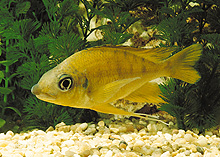
Still bred by commercial farms, Ophthalmotilapia
nasuta "Kipili" is a colorful orange morph originally collected south
of Kipili. |
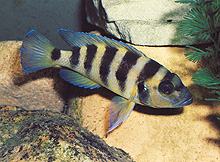
Found along the Tanzanian coast, Neolamprologus
sexfasciatus "gold" is available at adult sizes from time to time.
Photo by T. Koziol. |
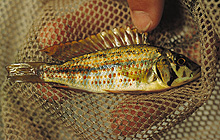
Available by special order, Ctenochromis horei
is
an import from Zambia. |
Lake Malawi
Malawi cichlid fans are still enjoying good supplies of colorful varieties.
While Mozambique collections are off line, those from along the Tanzanian
and Malawian coasts are strong. Some of the marginal exporters have
given up due to depressed export prices; others have concentrated on colorful
items available within a smaller, more manageable collecting area.
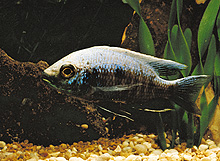
Sold as Haplochromis mloto, and recently described
as Copadichromis trewavasae, the specimen from Tanzania pictured
shows a strong area of white on the dorsum. |
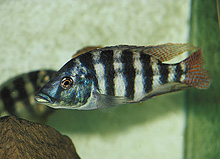
Not often exported, Placidochromis johnstoni has
been collected at Magunga (Tanzania) where the females show yellow casts.
Photo by T. Koziol. |
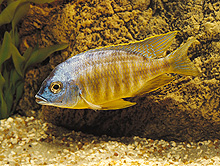
From Lupingu (Tanzania), Placidochromis sp.
"yellow electra" sports black ventral fins as juveniles. |
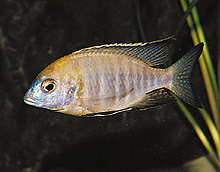
Collected in many areas, but exported recently from
Tanzania, Lethrinops sp. "nyassae" or the yellow-capped Lethrinops is caught
over open sand. |
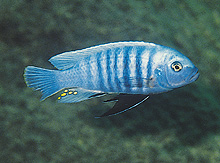
Metriclima zebra from Manda north along
the Tanzania coast sports a shiny, whitish blaze and a blue-black face. |

Originally from Usisya (Malawi), the yellow color
of Pseudotropheus elongatus is more evident during sexual displays. |
Victoria
There has been a shortage of good news from collecting points in Uganda.
The search for new material is underway, but no new exports of late.
Victoria fans need to wait and see what will develop.
West Africa
Collecting activities have slowed down in some West African nations,
while they have stopped altogether in others due to low variety and importers'
unwillingness to deal with limited saleable species. Exports from
Congo and Nigeria are strong, as are supplies of bred items.
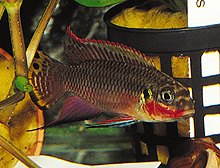
Pelvicachromis taeniatus sp. "Nigeria red"
is often available from specialized breeders. |
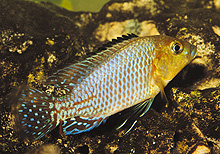 Infrequently bred or exported, Pseudocrenilabrus nicholsi is a bluish
morph found across northern Central Africa. Photo by T. Koziol.
Infrequently bred or exported, Pseudocrenilabrus nicholsi is a bluish
morph found across northern Central Africa. Photo by T. Koziol. |
Madagascar
This large island's cichlid fauna is losing ground to "human impact"
(e.g., deforestation and exotic introductions) and mother nature's recent
hurricane activity. About ten captive-raised species are now available
to hobbyists who want to keep these interesting and threatened animals.
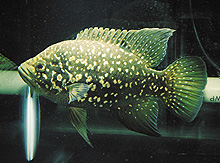
Bred in good numbers, the large-spotted form of Paratilapia
polleni (formerly known as P. bleekeri) is still the most popular
Madagascar selection. |
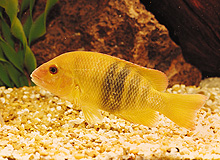 Infrequent spawners (and therefore infrequently available), Paretroplus
nourissati (known as orange Lamena) is recommended to only the most
serious cichlidophiles!
Infrequent spawners (and therefore infrequently available), Paretroplus
nourissati (known as orange Lamena) is recommended to only the most
serious cichlidophiles! |
Neotropics
Collecting season has just begun in South America, with dwarf apistos,
geophagines, and discus leading the list for import items. Specialized
breeders complement the wild menu with an array of selections — some very
rare indeed!
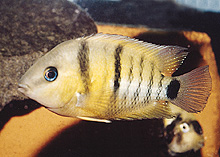
Originally from Honduras, Archocentrus "cutteri"
has proven to be a popular bred item.
Photo by J. Rapps. |
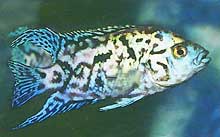
A new variety of Jack Dempsey (Nandopsis octofasciatus)
called the "blue dempsey" has an unusual blue calico pattern, as well as
longer finnage. Photo by J. Rapps. |
|











 Infrequently bred or exported, Pseudocrenilabrus nicholsi is a bluish
morph found across northern Central Africa. Photo by T. Koziol.
Infrequently bred or exported, Pseudocrenilabrus nicholsi is a bluish
morph found across northern Central Africa. Photo by T. Koziol.
 Infrequent spawners (and therefore infrequently available), Paretroplus
nourissati (known as orange Lamena) is recommended to only the most
serious cichlidophiles!
Infrequent spawners (and therefore infrequently available), Paretroplus
nourissati (known as orange Lamena) is recommended to only the most
serious cichlidophiles!
